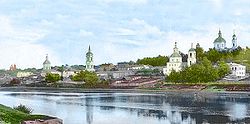
Dorogobuzh
Encyclopedia

Dorogobuzhsky District
Dorogobuzhsky District is an administrative and municipal district , one of the 25 in Smolensk Oblast, Russia....
of Smolensk Oblast
Smolensk Oblast
Smolensk Oblast is a federal subject of Russia . Its area is . Population: -Geography:The administrative center of Smolensk Oblast is the city of Smolensk. Other ancient towns include Vyazma and Dorogobuzh....
, Russia
Russia
Russia or , officially known as both Russia and the Russian Federation , is a country in northern Eurasia. It is a federal semi-presidential republic, comprising 83 federal subjects...
, straddling the Dnieper River
Dnieper River
The Dnieper River is one of the major rivers of Europe that flows from Russia, through Belarus and Ukraine, to the Black Sea.The total length is and has a drainage basin of .The river is noted for its dams and hydroelectric stations...
125 kilometres (77.7 mi) to the east of Smolensk
Smolensk
Smolensk is a city and the administrative center of Smolensk Oblast, Russia, located on the Dnieper River. Situated west-southwest of Moscow, this walled city was destroyed several times throughout its long history since it was on the invasion routes of both Napoleon and Hitler. Today, Smolensk...
and 71 kilometres (44.1 mi) west of Vyazma
Vyazma
Vyazma is a town and the administrative center of Vyazemsky District of Smolensk Oblast, Russia, located on the Vyazma River, about halfway between Smolensk and Mozhaysk. Throughout its turbulent history, the city defended western approaches to the city of Moscow...
. Population:
It originated before the Mongol invasion of Rus' as a fortress defending eastern approaches to Smolensk
Smolensk
Smolensk is a city and the administrative center of Smolensk Oblast, Russia, located on the Dnieper River. Situated west-southwest of Moscow, this walled city was destroyed several times throughout its long history since it was on the invasion routes of both Napoleon and Hitler. Today, Smolensk...
. In 1508, Vasily III sent Italian masters to build a wooden fort there. The town was ravaged during the Time of Troubles
Time of Troubles
The Time of Troubles was a period of Russian history comprising the years of interregnum between the death of the last Russian Tsar of the Rurik Dynasty, Feodor Ivanovich, in 1598, and the establishment of the Romanov Dynasty in 1613. In 1601-1603, Russia suffered a famine that killed one-third...
, and its population was reduced to ten men in 1614. Between 1611 and 1668, the town belonged to Polish-Lithuanian Commonwealth
Polish-Lithuanian Commonwealth
The Polish–Lithuanian Commonwealth was a dualistic state of Poland and Lithuania ruled by a common monarch. It was the largest and one of the most populous countries of 16th- and 17th‑century Europe with some and a multi-ethnic population of 11 million at its peak in the early 17th century...
as a part of Smolensk Voivodeship
Smolensk Voivodeship
Smolensk Voivodeship was a unit of administrative division and local government in the Grand Duchy of Lithuania and later the Polish–Lithuanian Commonwealth....
. Subsequently, the town survived other foreign invasions and numerous fires.
The principal points of historic interest lie outside the city proper. The 18th-century estate of Aleksino, for instance, used to be reputed for its stud-farm of Orlov stallions. The Boldin Monastery, dating from the 15th century, was renovated by the Godunov
Godunov
Godunov is a Russian surname.Godunov can refer to the following:Two Tsars of Russia and their kin:** Tsar Boris Fyodorovich Godunov a regent of Russia from 1584 to 1598 and then tsar from 1598 to 1605...
family in the late 16th century. The Godunovs commissioned a five-domed cathedral, a tented refectory, and a pillar-like bell-tower to be built there. According to Peter Baranovsky, the abbey represented the best-preserved 16th-century monastery complex in Eastern Europe
Eastern Europe
Eastern Europe is the eastern part of Europe. The term has widely disparate geopolitical, geographical, cultural and socioeconomic readings, which makes it highly context-dependent and even volatile, and there are "almost as many definitions of Eastern Europe as there are scholars of the region"...
. It was blown up by the retreating Germans in 1943 but was partly rebuilt in the 1990s.

